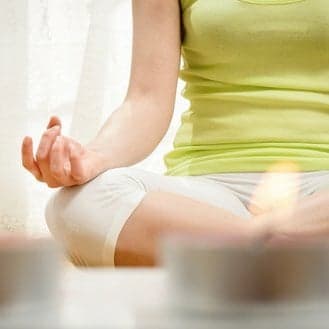I have never been an entirely successful meditator, and I doubt that I’m alone. Any time I’ve ever tried to sit still and clear my head, my nose twitches uncontrollably. My hair feels funny. My mind zeros in on one thing and one thing only: Try to ignore your itchy body.
I used to think that my restlessness would keep me away from meditation—at least until I decided to really buckle down and somehow master the art of sitting still. But, as it turns out, we seekers of peace and stress reduction don’t have to fold ourselves into Lotus pose before sunrise to reap the health benefits of this Eastern practice.
“There is certainly great value in doing a sitting meditation,” says Bob Stahl, PhD, a teacher of mindfulness-based stress reduction and author of A Mindfulness-Based Stress Reduction Workbook. “But there are also ways to practice being mindful in whatever activity we are doing.”
And it only takes a few minutes out of your day. If you’re a meditation novice like me, here are two simple adjustments you can make to your daily schedule to relax and clear your head.
Check In With Yourself
We often have days when we’re inundated with more emails, meetings, and phone calls than we can handle. We forget about lunch, and by the afternoon, we can’t quite remember the last time we looked away from the computer screen, had a drink of water, or peed.
The problem with running on autopilot is that we’re going about our business, but we’re not really focusing on what we need or what’s most important at any given moment. To combat this, Dr. Stahl advocates “mindful check-ins”—or, one-minute pauses throughout the day to refocus and recalibrate. The acronym he uses to explain this method is S.T.O.P., which stands for Stopping, Taking a breath, Observing, and Proceeding on with presence.
Since I started officially checking in with myself throughout my day, this very simple act of taking a breath and observing my body has made me notice, among other things, my tendency to clench my hands when I type. So after the check-in, I give them a stretch. Or, I’ll realize that I need to drink some water, relax my shoulders, or look away from my computer screen. When I return to what I’m doing a minute later, I’m more relaxed and balanced.
It’s so simple, this stopping technique. The only hard part is remembering to do it. So try giving yourself these minutes at regular intervals throughout your day. You might even set yourself a “check-in reminder” on your phone.
Check Out Your Surroundings
A few months ago, I was on my way to the airport in a taxi. Feeling stressed and rushed, I stuck headphones in my ears and scrolled through my Twitter feed.
A text bubble popped up on my screen from my boyfriend, also on his way to the airport in another cab. “Can you believe this sunset?” it read.
I looked up to see a sky that was a rare shade of pink—something I’d almost missed while clicking on link after link on my phone.
Sound familiar? We’re so often in our own heads (or phones) that we’re tuned out to what’s going on around us. We often convince ourselves that somewhere else is better than where we are instead of tuning into the moment we’re in right here, right now, and appreciating it for what it is.
I’ve noticed that trying to go through my day more deliberately—to get off autopilot—has helped to reshape my experiences in small but important ways. A few days ago, when I got off the subway after work, I took my headphones off. Taking a breath, I looked at the newly changed red and yellow leaves on the sidewalk trees, listened to the rumble of cars driving by, and heard the yelping of two siblings on scooters and a harried father chasing behind them.
This act of really noticing my surroundings didn’t solve my problems, and it didn’t bring me instant joy. But, arriving home a few minutes later, I felt just a little more calm than usual when I walked through the door.
No matter how busy you are, these “meditation” techniques don’t require your time as much as they require a shift in your awareness throughout the day—a choice to focus on the present moment. And that doesn’t mean you have to stop your mind from wandering, you just have to pause and be aware.
So try it out. In time, you may even start to feel like adopting a more formal mindfulness meditation program, which, studies have shown, have actually changed the parts of the brain associated with anxiety and stress.
But even if you never end up in Lotus pose, you can learn to live a bit more peacefully by simply mastering the art of paying attention.

